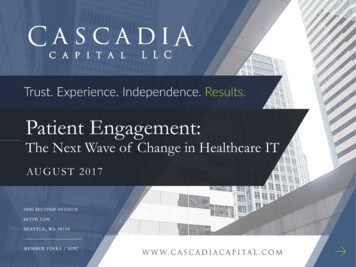
Transcription
Patient Engagement:The Next Wave of Change in Healthcare ITAU GU ST 2017
Core Problems That Need To Be Addressed18%National health expendituresaccounted for 18% of the GDP in2015, and are expected to increaseto 20% by 2025. This is a cripplingproblem to our economy andpresents a major spotlight in thepolitical environment.Source: Rock Health, StartUp Health, Accenture, Markets and Markets, CMS.gov, Forbes.The average consumer spends less than.01% of their life in clinics, yet healthcarespending accounts for nearly 20% of theGDP. In an era of shifting care models,providers can no longer be successful bysimply providing paid services; rather,they must also achieve outcome success.1
The Regulatory Environment is Focused on Reducing CostWithout Negatively Impacting Quality of Care or Outcome Digitization AccessFeb: HITECH ActMar: PPACA200920102011Jan: MLR, Stage 1 ofMeaningful Use (MU) HITECH Act: a bonanza forincumbent EHR vendors ACA driving shift fromvolume to value Healthcare Reform aims tostabilize the status quo and createparallel in delivery models Cadillac Tax (delayed): a bonanzafor health innovatorsSource: Cascadia Capital, Wall Street Journal. Outcome-DrivenJan: ACO MedicareincentivesJan:Individual MandateOct: CMS paymentsfor VBPMedicaid expansion20122013Oct: Openenrollment begins20142015Cadillac Taxpotentially delayedbeyond 2025Stage 3 of MU201620172020 King v. BurwellDec:Stage 2 of MUAffordable Care ActMedicare Access and CHIPReauthorization ActTrump’s Health PlanHealthcareReformImplication Capped funding, blockgrantsMedicaid plans are forced toinnovate, low-income affectedmost Reduce or repeal thesetaxes for businesses andhigh-income householdsHundreds of billions of dollars intax revenue lostMost Americans required topurchase health insurance Individual mandate replacedwith less robust tax creditsto help people affordhealthcareFewer people insured premiumsincrease - disproportionatelyaffects the old and the low-incomepopulationMandates for coverage that statesmust require insurers to provide(such as maternal leave) More jurisdiction left tostatesMore flexibility for states, lesscomprehensive coverageMedicaid expansion remainsIntroduced taxes, such as oninvestment income, capital gains,and payrollThe Trump Administration’s argument is that Americans should feel like they are spending their own money onhealthcare services. This will make Americans more active and aware of their spending choices, empowering themas consumers.2
Key Drivers:Healthcare Undergoing a Revolution in Service Model1. Shifting Service Model2. Consumerization and theTransition to ConsumerWellness3. Technology Enablers4. Generational Changes5. Alternative Care PlatformsProviders are increasingly facing financial incentivesand pressures to improve patient engagement, drivinga shift in service models to reduce unnecessaryfinancial waste in an overburdened system.Increased focuson wellnessRising out-of-pocket costs have madepatients more price-sensitive andlikely to shop aroundRegulatoryrequirementsFee for ServicePatients are becoming moreeducated consumers withmore access to shopping toolsImproved outcomesknowledge and standardizequality reportingPatient–doctorcommunication hasimprovedValue-Based CareMedicare’s valuebased purchasingIncreased payer-providerrelationships incentivizeproviders to improve outcomesby increasing engagement3Source: Rock Health, StaratUp Health, Accenture, Markets and Markets, CMS.gov, Forbes.
Key Drivers:Consumerization is Spreading to Healthcare1. Shifting Service Model2. Consumerization and theTransition to ConsumerWellness3. Technology Enablers4. Generational Changes5. Alternative Care PlatformsTraditionally, healthcareproviders treated conditionsas they arose, making moreby performing moreservices.Now, preventative care is king.The costs are less in the long-runthan treating acute or chronicconditions. Healthy patients meanshealthy profits.3 Major Trends in ConsumerizationC O N S U MERC H O I CEHealth Insurance Competition,Provider/Physician/Clinic Comparison ToolsC O N S U MERE M P O W ER MEN THealth Savings Accounts, Personal &Financial ToolsC O N S U MERWELLNESSLifestyle, Prevention, & ConsumerSelf-Management ToolsSource: Accenture, MediPENSE, eWeek. .4
Key Drivers:Consumers Leverage Technology to Gain Control1. Shifting Service Model2. Consumerization and theTransition to ConsumerWellness3. Technology Enablers4. Generational Changes5. Alternative Care Platforms7 in 10Previously, U.S. adults trackedat least one health indicatorand the means of tracking are remarkably primitive49%34%8%7%5%1%PAPERIN HEADAPPSPREADSHEETMEDICAL DEVICEONLINE TOOLAs digital health toolusage becomes morewidespread, there will bean abundance of patientengagement data. EHRvendors, health insurers,and other health systemstend to fiercely guard theirpatient information, buttechnology integration toincrease communication,organization and workflowwill alleviate the friction.Technological Advances are Encouraging UnprecedentedLevels of Patient Engagement46%Of consumers are considered digital health users,meaning they use 3 or more digital health tools.Greater data integration with currenthealthcare systems gives consumers moredecision making tools and drivesengagement.Source: Accenture, MediPENSE, eWeek. .5
Key Drivers:A New Kind of Patient is in the Waiting Room1. Shifting Service Model2. Consumerization and theTransition to ConsumerWellness3. Technology Enablers4. Generational Changes Boomers care most about cost value, but customer service and convenienceare most critical to millennials, who are beginning to utilize the healthcaresystem more regularly. Millennials prioritize having knowledgeable providers and quick issueresolution so much that they are far more willing to switch providers,driving competition and encouraging providers to offer better care. Millennials’ prioritization of convenience also makes them more open totelehealth and alternative mediums of care.5. Alternative Care Platforms6Source: CDC; Truven Analytics; Center for Connected Health Policy, as of September 2014; Teladoc; Accenture.
Key Drivers:Future of the Doctor-Patient Encounter1. Shifting Service Model2. Consumerization and theTransition to ConsumerWellness3. Technology Enablers4. Generational Changes5. Alternative Care PlatformsMillennial Workforce Preferences for Convenienceare Driving a Shift to Telehealth1.25bnAmbulatory carevisits per year in US71%417mmof employer-sponsored ERvisits not necessaryEmployees are open to virtual care33% could be treatedthrough telehealthAnd employers are responding54% of 18-29 Year Olds49% earn 71,00048%Offered telehealthservices in 201574%Offered telehealthservices in 2016 Telehealth can be used to replace 1/3rd of in-patient visits, and is attractive for its low costand convenience. This medium of care works particularly well for concerns that do notrequire lab work, such as behavioral health, radiology, rehabilitation, and dermatology. New primary care models are providing platforms to make physicians more accessible topatients, whether through a virtual platform enabling 24/7 messaging or video conferencing,personalized treatment plans, or through live visits to the patient’s home, office, or hotel. Advancements in remote patient monitoring are also providing physicians with new ways totrack patient status using data collection tools (such as wearables) after discharge from aclinical setting, consequently reducing follow up visits, readmission rates, and healthcaredelivery costs.Source: CDC; Truven Analytics; Center for Connected Health Policy, as of September 2014; Teladoc; Accenture.7
Record Based Deal Activity for Patient EngagementPrivate Equity Financing Deal Volume Q1 and Q2 2017 data shows that deal count and deal volume are ontrack to greatly exceed 2016 benchmarks. Private placement average deal size has grown substantially inrecent years, indicating that VC/PEs are not only making moreinvestments but are also making larger bets. 2,728 ( in Millions) 2,180 The high proportion of early stage financings signals that patientengagement is a young space, explaining why M&A activity has notcaught up yet, although we can expect M&A to accelerate in thecoming years. 1,364 271 Series B through E financings are growing as a percentage of totaldeal activity over the years, signaling the beginning signs ofmaturation and a healthy appetite for venture and growth equitydeals in the market.2012 598 640 76220132014201520161H 2017Annualized 2017 Projection*M&A deals volume not shown due to the number of undisclosed transaction values.Financing vs M&A Deal te Equity Financing Activity by 013Financing Deal Count20142015M&A Deal CountAnnualized 2017 ProjectionSource: PitchBook, StartUpHealth, Rock Health.20161H 20170%Seed25%Series A50%Series BSeries C75%Series D100%Series 8
Patient Engagement LandscapeData Analytics and Outcome /Survey ResultsWorkflow / Scheduling / PatientRelationship ManagementProvider solutions focused on maximizingthe patient experience through ease ofaccess, scheduling, communication, etc. Facilitation of care coordinationEHR integrationPatient-provider communicationAppointment booking, scheduling andremindersPatient relationship managementDisease Management and MedAdherenceGuidance providers for patients withchronic conditions, helping them betterengage with their care, reduce risk, andimprove overall health. Preventative measures to manage riskDaily guidance, reminders, etc., toincrease patient engagement withcare planDrug complianceSource: PitchBook, Capital IQ, Cascadia Capital.Leveraging big data (from EHRs, clinicaltrials, etc.) to help providers improvehealth outcomes. Clinical trial data aggregation andanalysis Patient surveys to evaluate providerperformance and measure results Predictive analyticsDisease / Condition / PopulationFocusedHealthcare companies offering servicesto a specific population subset, enablingaccess to specialized care and advice. Age-specific (ex. senior care) Condition-specific (ex. diabetes,cancer, obesity)Broad PatientEngagement UniverseMost companies can be identified inseveral categoriesPersonal Health ToolsDigital health tools centered aroundpatients (as a consumer), enabling themto track health status, manage spending,and make educated decisions. WearablesConsumer appsSocial MediaConsumer facing engagementCommunity platform softwareOn Demand CareVirtual platforms offering real-time, 24/7remote service, thereby increasing patientconvenience and physician accessibilitywhile lowering costs. TelemedicineProvider home-visits at patient’sconvenienceDirect messaging with health providerRemote patient monitoring9
Patient Engagement Landscape (Cont.)Data Analytics and Outcome /Survey ResultsDisease / Condition / PopulationFocusedWorkflow / Scheduling / PatientRelationship ManagementBroad PatientEngagement UniverseDisease Management and MedAdherenceMost companies can be identified inseveral categoriesOn Demand CarePersonal Health ToolsNote: Companies displayed in the landscape are illustrative examples.Source: PitchBook, Capital IQ, Cascadia Capital.10
Patient Engagement Industry OutlookIndustry Life CycleIndustry OutlookAs an emerging industry subsector, patient engagement technology has relativelylow barriers to entry, encouraging many new disruptive entrants and businessmodels. The Healthcare IT market overall is fairly developed, with robust M&A activitymaking consolidation the norm for future years. Within HCIT, patient engagement is still a growing sub-vertical of the market, so itsM&A activity lags behind that of the overall industry. There are, however, alreadybeginning signs of rapid development and growth, evidenced by the shift in fundingvolume to later stage and larger size private deals. Elements of patient engagement will eventually find ways into all of digital health assoftware vendors integrate new technology centered around patients as aconsumer. Expected Patient Engagement Market GrowthCascadia Thoughts Seed /EarlyGrowth 7B 10BMidStage 12B 14BLateStage 17BConsolidation 35B 22B 27B2016 2017 2018 2019 2020 2021 2022 2023Source: Markets and Markets, Grand View Research. Communication is a critical part of achieving better patient outcomes and driving downcosts; patient engagement is here to stay and has the potential to become thebackbone of the new healthcare system.It is still early in the patient engagement wave; equity dollars are flowing freely andinvestors are focused on the customer base and compelling/sticky use cases.EMR vendors aren’t going to open up their communications, so patient engagementcompanies need to provide interoperability.Scale and broad service offerings are crucial elements of success in the sector. Expectconsolidation as the leaders establish themselves; big equity dollars are the first sign.Partnering with a service delivery company will help drive patient engagementtechnology into the healthcare system. Smart technology companies will embrace thepeople that drive change – “Nurses will rule the earth and millennials will show theirparents the way.”Given the volume of dollars flowing into the sector we expect a robust M&Aenvironment in the next few quarters.1111
Patient Engagement Deals and InvestorsLargest Financing Dealsin Q1 & Q2 2017CompanyMost Active Investors 2015-2017 YTDInvestedFirm# ofDealsMost Funded Companies(1)CompanyTotalRaised 600M5 600M 231M5 422M 140M5 364M 100M5 322M 21M5 203M 15M4 170M 13M4 164M 11M4 164M 11M4 126M 10M3 108M(1) Companies with the largest amount of total equity capital raised to date.Source: PitchBook.12
Unprecedented Recent Investor Activityand More to Come 3.8BTotal Raised 2016– 2017 YTDInvestors that haveinvested in thefollowing companies233PrivatePlacement DealsNote: Selected sample of companies and investors./13
CASCADIA CAPITALOVERVIEW14
Our FirmFounded in 1999Cascadia has a successful 18 year OVER245Leading diversifiedinvestment bank M&A, private placements, advisory services Specialized in-depth expertise across multipleindustry verticals Representing clients in the US and globally,including Europe, Asia and Australiainvestment bankingprofessionalsManaging Directors infive citiestransactions completed,with more than 8 billionin aggregate valueHeadquartered in Seattle, withManaging Directors in Los Angeles,Minneapolis and New YorkExperienced team withsuccessful track record Cascadia is the investment bank of choice forentrepreneurs and family-owned companies Decades of investment banking and operationalexpertise Deep capital markets expertise15
Providing a Full Suite of Banking ServicesM E RG E R S &AC QU I SIT ION SWe have completed hundreds of M&A transactions ranging insize from 20- 500 million. Our thorough and disciplinedprocess, in combination with our deep industry expertise, hasresulted in a proven track record of delivering successfuloutcomes for our clients.C O R P O R AT EFINANCEWe have extensive experience placing equity and debtcapital ranging from 10- 250 million. We leverage ourdeep relationships with institutional investors; includingprivate equity, growth equity, venture capital, family office,mezzanine and venture debt, hedge funds and BDCs.S T R AT EG I CA DV I SO RYS E RV IC ESWe provide our clients with analytical data and insights tofacilitate strategic decision-making. We advise our clients onhow to maximize shareholder value and then provide supportfor transaction implementation.P R I VATEC A P I TALWe listen carefully to business owners and managers and thenwork closely with them to custom design long-term andflexible capital solutions. Our approach resonates particularlywell with family-owned and closely-held companies.ENGAGEMENTS INCLUDE: Mergers & Acquisitions (Buy & Sell Side)Corporate DivestituresManagement BuyoutsLeveraged BuyoutsRecapitalizationsPartial Liquidity EventsPrivate Equity Capital RaisesPublic Company Capital RaisesDebt Financings & RestructuringsProject FinanceValuationsFairness OpinionsShareholder Rights PlanningShareholder Value AnalysisStrategic Alternatives ReviewsStrategic Partnerships & Joint VenturesSpecial Situations16
Healthcare & Digital Health PracticeAuto AftermarketBusiness ServicesConsumer & RetailPrincipal Sector Focus Consumer Driven Health IT & Mobile HealthClinical Workflow & Practice ManagementInsurance & ReimbursementsMedical Devices Care Coordination Healthcare Services Data Analytics & HC InformationEnergy & Applied TechnologyOverviewFood & AgribusinessReal EstateWe have four professionals with over 40 years of collective experience who haveoriginated and executed over 1 billion of M&A and financing transactions in theHealthcare sector. Emerging trends in the industry are driven by consumers demandinghigher quality care with cost transparency, integrated health information, and betterprovider access and communication. The solutions lie at the intersection of healthcareand technology, where innovation provides for better, more accessible care at lowercosts. Cascadia’s team is perfectly primed to meet the growing needs of the industry’splayers, leveraging vast experience coupled with a thorough understanding of the market.TechnologyRepresentative TransactionsHealthcare & Digital HealthIndustrials17
patients more price -sensitive and likely to shop around. Increased payer -provider relationships incentivize providers to improve outcomes by increasing engagement. Increased focus on wellness. Improved outcomes knowledge and standardize quality reporting . Source: Rock Health, StaratUp Health, Accenture, Markets and Markets, CMS.gov, Forbes. 4; 1. Shifting Service Model 2. Consumerization .

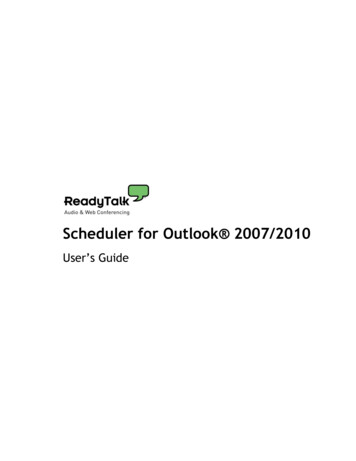
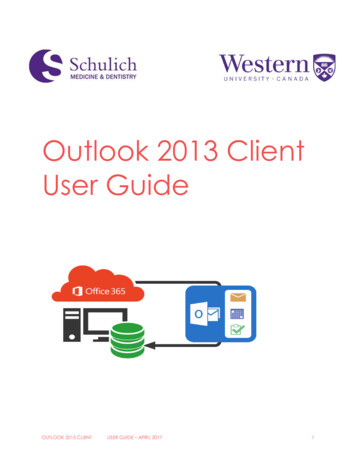
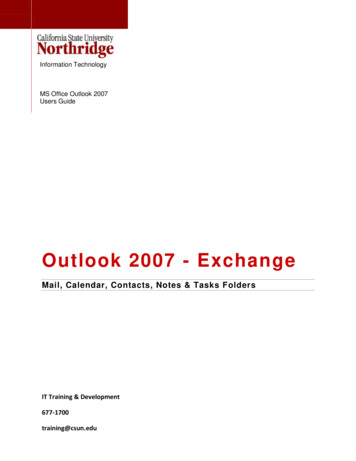

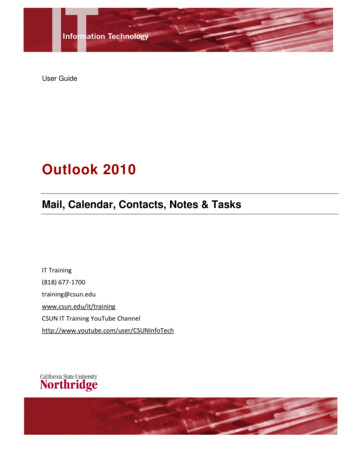
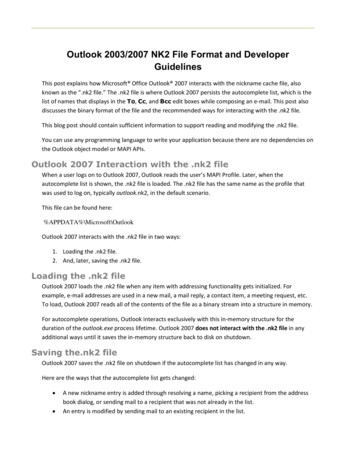
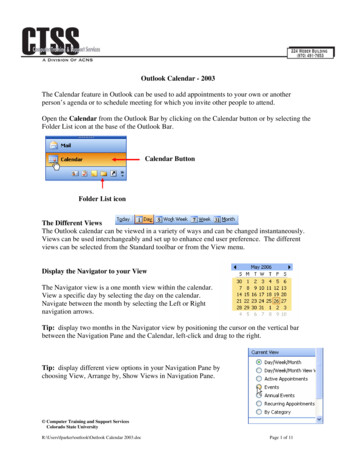
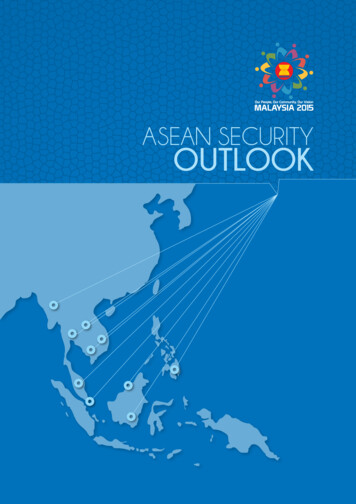
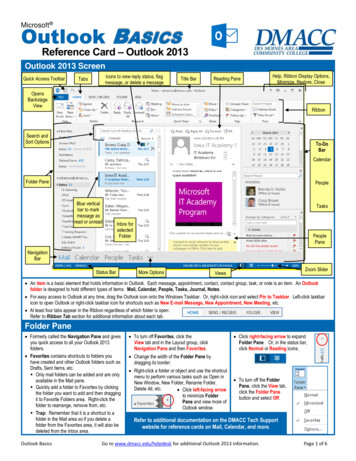
![Bosch ESI[truck] Heavy Duty Truck Software Update – Q2 .](/img/22/bosch-esitruck-heavy-duty-truck-release-notes-details-2019-2-0-0-0.jpg)